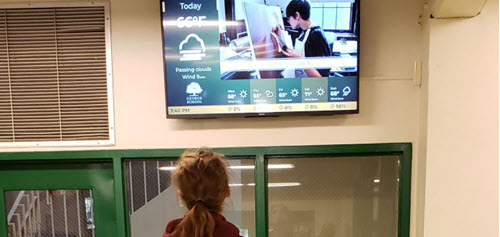George School is a 128-year-old Quaker coeducational boarding and day school in Pennsylvania. It’s home to 540 students representing 37 countries and 18 states. Well known for academic excellence, George Schools has a 95% IB Diploma completion rate, one of the world’s highest. Michael Hodgin is the Director of Technology at George School and has been with the school since 2000. Before George School, Michael worked as the Director of Technology at a school in Maryland and was a mathematics teacher.
Digital signage has always been compelling to Michael, and he first got into it almost ten years ago. Michael started by researching paid and free solutions for George School. Unfortunately, Michael’s research found that most paid digital signage solutions were too expensive, and the free solutions were too complicated to set up and manage. Then, in 2014 a peer-recommended Rise Vision to Michael. The timing
was perfect as George School had a new athletic center that needed signage. Michael tried out Rise Vision and was impressed by the low cost and ease of use. Michael got funding and started the process to get their digital signage up and running.
Location Driven Communication
To start, Michael installed four digital signs in the George School athletic center. The displays show athletic photos, a Twitter feed, a sporting events calendar, news from the Dean, and more. George School has since expanded to 12 digital signs. The
digital signs are in common areas, the science center, admissions office, dining hall, Dean’s office, library, art department, and the athletics center.
George School uses a location-driven communication strategy. The people who run each location manage the content for the digital signs in their area. There are now nine people logging into Rise Vision and making changes to the content. The signage shows 70% location-specific content and 30% content that is relevant to the whole school. This ratio changes in common areas, which display information relevant to
everyone.
George School sources content from a variety of places:
· They pull content from the school and athletics Twitter accounts
· Most locations have a Google Slides presentation specific to them
· The digital signs pull stories via RSS from the Dean’s blog
· And they are frequent users of the Rise Vision templates
Some examples of content that George School shows are:
· Sharing meal menus
· Bulletins and announcements from the Dean
· Athletic events, photos, and news
· Student artwork
· Upcoming theater events
· The daily school schedule
George School was recently able to see the impact of its digital signage. Because of the pandemic, George School needed to support remote and hybrid learning, which significantly changed the way periods work. George School was able to turn to their digital signage to communicate this change and keep everyone informed of the daily class schedule.
George School’s approach to digital signage is practical. They get many people involved in managing content. They reuse content from several sources. And they avoid trying to share everything with everyone and instead keep their messages targeted.
Goals For The Future
These are still early days for George School, as many of the displays went live in the 2021-22 school year. Michael has been the number one proponent for implementing Rise Vision digital signage at George School. He adds Rise Vision tech support has been excellent.
“When I hit a wall, they have been quick to send me short 30 second videos of exactly
what I need to do, and I can keep rolling.”
Overall it has been a soft launch thus far, but committees are taking notice. Michael has watched people observing the signs commenting, “Hey, that’s cool,” and he is excited for more feedback to come. George School is modernizing and upgrading technology throughout the school. For example, George School recently purchased the Unlimited License, which provides them with unlimited displays. So Michael is testing Rise Vision on Airtame devices for use in classrooms and other locations in the school. The expanded digital signage will make it easier for George School to keep faculty and students informed.
As Michael says, “In the past, in the student union area, they had bulletin boards for posters, which had stopped because people got out of the mindset that this is what we need to do, yet that function is still practical, and the digital sign replaces it well. With digital signage, you can make the modifications from anywhere without printing flyers and walking around to put them up in places.”
Source link



